| , Thanks for your supports during the past 17 years, as we have exchanged mails on spare parts and projects business. Our main business are Project EPC consulting, equipment and spare parts supply thanks to the supports from famous EPC contractors and manufacturers, with whom we are working very well for years. Photovoltaic is a clean and renewable energy source that represents the future trend. China has the most complete photovoltaic production lines and industrial chains. We conduct in-depth cooperation with professional and reliable partners with various advantages to meet various needs of users, such as photovoltaic power stations, photovoltaic carports, photovoltaic street lamps, photovoltaic panel production lines, and other various photovoltaic systems, equipment, or materials. Here is an introduction to some of products and services. For any other requirements, please contact us. 1. Container expandable photovoltaic system The container expandable photovoltaic power generation system integrates the photovoltaic power generation system into a container. It can be quickly transported by trucks, ships, etc., and is a new type of photovoltaic power generation system that can be deployed at any time. Through the innovative combination of "standardized design + intelligent management + expandable energy storage", the system can be applied to various scenarios such as daily life and production, remote areas, and disaster backup and emergency response. In addition, customized services for products can be provided according to customer needs to meet electricity demands of different scales. Key Information | Details | 01 Transportation Method | Utilize flatbed trucks, semi - trailers and other vehicles for transportation. Use cranes to load and place containers. | 02 Dimension Parameters | The product adopts a 20 - foot container.
Unfolded dimensions: 20.5(W) × 9.0(D) × 2.6(H) m *
Closed dimensions: 2.4(W) × 6.1(D) × 2.6(H) m * | 03 Photovoltaic Modules | Can install various mainstream 550W - 720W photovoltaic module products on the market according to specific customer needs. | 04 Power Generation | Total power generation range: Up to 26 - 40KW
Estimated annual power generation: 29,000 - 45,000 KWh * | 05 Erection Method | A single person can complete the e ntire erection work.
Erection and power generation can be completed in 20 minutes. | 06 Customized Services | Can select inverter brands/models, cable lengths and other needs for various scenarios according to customer requirements. |
2. Introduction to Container Expandable Photovoltaic System Photovoltaic modules with a power range of 550Wp - 715Wp are selected. One photovoltaic container can accommodate 28 modules on each side, with a total of 56 modules installed, resulting in a capacity range of 30.8kW - 40.04kW. The expansion method is easy to operate, and a single person can complete the entire erection work for one photovoltaic container in just 20 minutes. Expansion Method: Step No. | Step Name | Description | Image | 01 | Site Selection and Placement | In the early stage, select a suitable location with flat land and sufficient sunlight, and use a vehicle to place the container. | 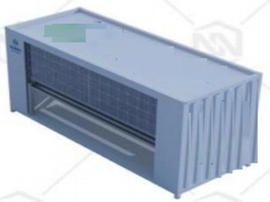
| 02 | Fix the Bracket | Extend the slide rail by rotating the slide rail shaft, then pull the extension rod to the preset position and fix it. | 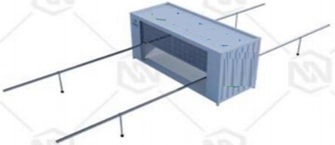
| 03 | Unfold the Modules | Pull the modules outward along the rails to the preset positions, and then check if each module is laid flat. | 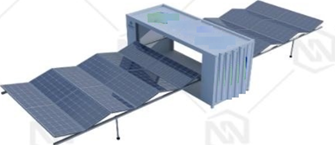
| 04 | Push Out the Modules | Open the lateral rails on the lower side of the modules, pull the outer modules to the preset positions, and check if there are any abnormalities. | 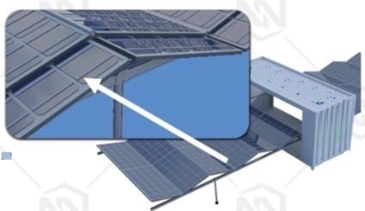
| 05 | Check and Operate | Connect the relevant output wires, check if the inverter equipment operates normally, and then it can enter the power - generation state. | 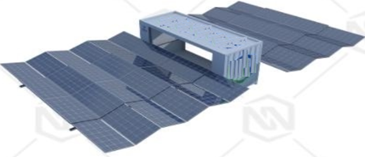
|
Based on the data calculated by PVsyst, Nigeria has abundant solar radiation, and the overall level is relatively high. The annual cumulative radiation is about 1250 - 2800 kWh/�? After calculation, the number of power generation hours is about 1025 - 2296 hours. For the photovoltaic modules, 550Wp - 715Wp modules are selected. One photovoltaic container can install 28 modules on one side, with a total of 56 modules installed. The capacity range is 30.8kW - 40.04kW, and the power generation is about 31,600 kWh - 91,900 kWh.
Core Advantages:
- Rapid Deployment: It is the biggest advantage, meeting the needs of emergency power supply, temporary power consumption, and rapid project startup.
- Modularity and Scalability: One container is an independent power generation unit. When a larger capacity is needed, multiple container units can be placed side by side like building blocks. Usually, a monitoring system is also integrated, facilitating remote management, operation, and maintenance.
- Flexibility and Mobility: It can be easily transported to any place where electricity is needed (as long as there are roads or ports). After the project ends or the location changes, it can be quickly disassembled, loaded back into the container, and transferred to the next location for reuse.
- Reduced On - site Construction: Most of the installation work is completed in the factory. Only unfolding and connection are needed on - site, reducing the requirements for on - site construction conditions and labor, and also reducing the environmental impact and risks brought by on - site construction.
This mode is applicable to various scenarios, such as enterprise park production, agricultural greenhouses, expressway service areas, emergency disaster relief, and field construction.
3. Introduction to 215kWh Energy Storage Cabinet
The 215kWh commercial and industrial energy storage system consists of 5 Packs, one PCS, an electrical system (integrating a high - voltage box and a power distribution system), an EMS, a liquid cooling system, and a fire - fighting system. The system uses Weilan semi - solid - state 280Ah lithium iron phosphate battery cells as the minimum unit for energy storage. It adopts a two - level BMS architecture. In addition to the independent fire - fighting system and pressure relief valve at the Pack level, the system is also equipped with a pressure relief valve.
| Serial No. | Item | 215kWh |
|---|
| 1 | Battery Pack Configuration | 1P48S | | 2 | System Configuration | 1P240S | | 3 | AC Side Voltage Range | 380Vac | | 4 | Rated Power | 0.5P | | 5 | DC Side Energy Efficiency | �?5% | | 6 | Container Dimensions (WidthDepthHeight) | 130012002300mm | | 7 | Weight | �?.35T | | 8 | Protection Grade | IP55 | | 9 | Operating Temperature Range | -30 - 55�?/td> | | 10 | Operating Humidity Range | 0 - 95% (No Condensation) | | 11 | Cooling Method | Liquid Cooling | | 12 | Fire - Fighting Method | Perfluorohexanone + Aerogel + Water Fire - Fighting Interface | | 13 | Communication Interface | Ethernet | | 14 | Communication Protocol | Modbus TCP |
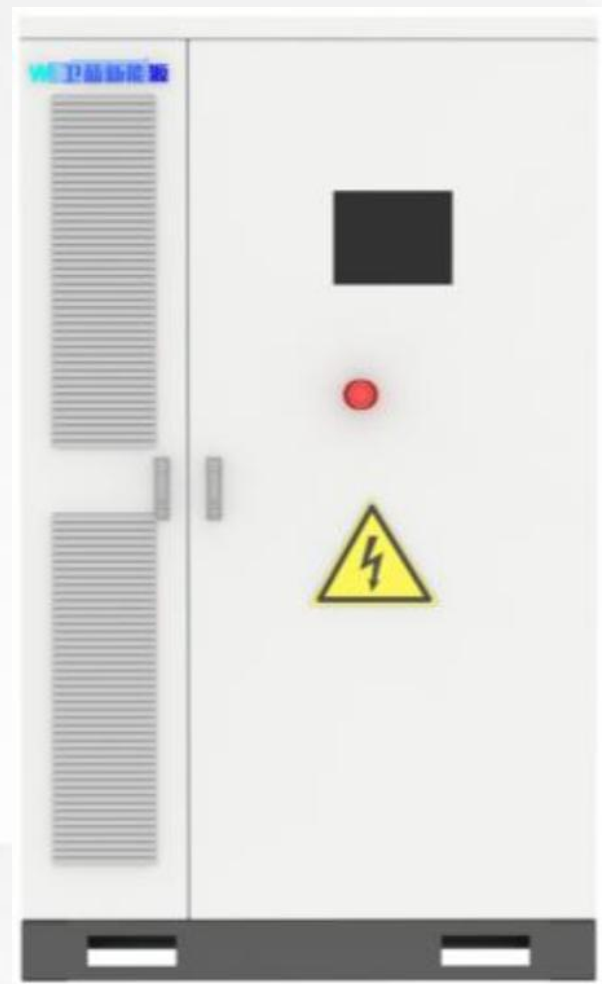
4. The average daily power generation of one photovoltaic container per year Taking the 715Wp module as an example, one container can be installed with a capacity of 40.04kW. Based on the solar radiation of 2037.6kWh/�?in Abuja, the capital of Nigeria, and a system efficiency of 82%, the calculated power generation hours are 1670.3h. The average daily power generation is as shown in the figure. The daily power generation is approximately 159 - 205kWh, and the power generation is relatively average, with an average daily power generation of approximately 183.4kWh.
5. Other applicable scenarios
1. Permanent/semi - permanent power supply in extremely remote areas:
- Remote villages and communities: Provide electricity for daily life (lighting, communication, TV, small appliances) and necessary public services (water pumps in health stations, lighting in schools) for residents in mountainous areas, grasslands, deserts, and islands where the power grid cannot reach.
2. Resource extraction bases (mines, oil fields, forest farms, islands):
- Provide electricity for production and daily life in exploration camps, operation areas, monitoring equipment, and living areas, getting rid of the dependence on expensive diesel transportation.
3. Border posts and patrol stations:
- Ensure the basic needs of communication, monitoring, lighting, heating/cooling in remote border posts, and improve the garrison conditions.
4. Mobile and temporary high - reliability power sources:
- Emergency rescue and post - disaster reconstruction: When the power grid is paralyzed due to disasters (earthquakes, floods, typhoons), quickly deploy to provide uninterrupted core power for command centers, field hospitals, shelters, and communication relay stations, ensuring the operation of lifelines. In the post - disaster reconstruction stage, supply power for temporary resettlement sites and construction equipment.
5. Temporary camps for major projects:
- Supply power for construction camps, equipment charging stations, and lighting and monitoring systems of projects such as railway/road construction (especially in uninhabited areas), water conservancy projects, and large - scale pipeline laying.
6. Scientific research and exploration bases:
- Provide reliable power sources for scientific research stations in extreme environments such as polar regions, plateaus, and deserts, supporting scientific research equipment and living security.
7. Location shooting sites for film and television:
- Provide stable and silent power sources for equipment such as lighting, photography, and post - production.
For the above scenarios, solutions with different optical storage capacities can be selected according to the actual electricity demand.
|

